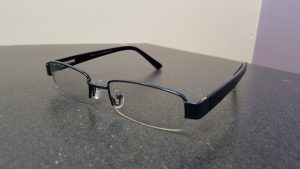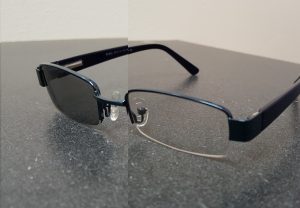By: Anthony Tangeman
I’ve lived in Florida my entire life and I’ve spent plenty of time exposed to the sun. Whether it was for sports, marching band or yard work, I almost always had a pair of sunglasses with me.
I had never owned a quality pair of sunglasses. I had always used cheap sunglasses that you could find at your local dollar store.
These glasses worked just fine as they helped reduce the intensity of incoming sunlight. As my eyesight started to diminish I started needing a prescription. I could not wear those cheap sunglasses anymore.
Just recently I was presented with various kinds of prescription eyeglasses that would help combat the harsh Florida sun. I was asked to give them a test-drive and to share my experiences.
The first pair I tried out had polycarbonate lenses with gray transitions (VII).

Up until this point I had only heard about transition lenses. I didn’t know anyone who owned a pair. On paper the concept sounded nice: Exposure to UV rays would automatically darken the lenses. Once you went indoors, the lenses would gradually become clear again. It seemed nice and convenient needing to have only one pair of glasses.
The first time I tried on the glasses I found the transition from clear to dark to be seamless. It is a gradual process and thus difficult to notice while it’s happening, but the lenses do activate quickly. I was happy with the amount of protection the lenses offered against the harsh sunlight. It wasn’t the best sun protection I’ve experienced, but the tint helped ward off the sun. After going indoors the lenses eventually transitioned back to clear. At that point it was like wearing my every-day normal pair of glasses with clear lenses.

As I had imagined, the lenses were certainly convenient. I started referring to them as my “jack-of-all trades glasses” as you could wear them in any situation, whether indoors or outdoors.
Of course, a jack-of-all trades is a master of none, and there are a few drawbacks with these lenses. While these glasses did help protect me against the sun, I found myself wanting some more protection. My lenses were not polarized, so I had a problem with glare. If you are like me and live in a southern, sunny climate, you may want to look for a stronger, more dedicated pair of sunglasses with polarization.
The most notable thing to understand about transitions is that it takes considerably longer for the lenses to deactivate than to activate. This is a problem when going from intense sunlight to indoors. It is almost as if you were wearing sunglasses indoors. It can make things difficult to see, depending on how dark the lens tint is. However, I never found the activated lenses to hamper my vision so that I wanted to take the glasses off indoors. It is something to keep in mind when thinking about getting a pair of transitions.
That being said, I cannot stress enough that wearing the inactive glasses indoors felt just like wearing my normal pair of prescription eyeglasses. They feel nearly identical to my regular pair of glasses. It’s amazing to me that you get clear glasses with the added benefit of a little bit of tint to help out with the sun.
Overall I’d say that transitions are great for the person who values convenience and sun protection in that they allow you to get by without a dedicated second pair of sunglasses.
As I said earlier, I find that these transitions are my “jack-of-all trades glasses.” They will get me through the day no matter the situation. If you go into transition lenses with this mindset, you’ll be more than satisfied with your glasses.
We’ll be continuing our review series with another pair of sunglasses, so be sure to look out for it. Hope to see you then!